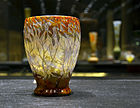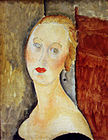Museum of Fine Arts of Nancy
You can help expand this article with text translated from the corresponding article in French. (July 2016) Click [show] for important translation instructions.
|




The Museum of Fine Arts of Nancy (French: Musée des Beaux-Arts de Nancy) is one of the oldest museums in France.
History
Established in 1793, the museum is housed in one of the four large pavilions on the Place Stanislas created in 1755 by Stanislas Leszczyński, duke of Lorraine.
In 1930, the town council decided to convert the building into a museum in order to host the fine art collection hitherto held in the city hall.
In 1999, the art historian Jacques Thuillier donated a huge collection of drawings (2,000) and engravings (13,000) to the museum.
Architecture
The building is composed of four different parts.
The museum is located in one the four pavilions of the Place Stanislas, constructed between 1752 and 1755. Initially, the pavilion in which the museum is located was home to a theater called "La Comédie" on the first floor, a medical college on the second and the apartment of the college dean on the third. The college moved during the 19th century and the theater burnt in 1906.
In 1930, the town council decided to convert the building into a museum in order to host the fine art collection hitherto held in the city hall. The brothers Jacques and Michel André (respectively architect and engineer), assisted by their father Emile André, designed a first project in January. One year later, the council organized a competition involving the André Family, Georges Biet and André Lurçat. The modernist project of the latter came third. Emile, Jacques and Michel André won the competition and designed the extension the construction of which began in 1933. The new building, made of reinforced concrete hidden by stone facades, remained unfinished after 1936.
The expansion of the collection necessitated a new extension during the 1990s. The architect Laurent Beaudouin and his team were put in charge of this new phase. They designed a museum organized as an architectural promenade through different conceptions of space. The 18th-century pavilion was restored and the extension of the 1930s transformed.
The archaeological excavations made during the construction of this last extension brought to light the oldest part of the museum's building: fortifications of the ancient town of Nancy, built during the 16th and 17th centuries. Nowadays, the production of the glass factory Daum is presented in this basement.
Collection
Some of the painters whose work is featured in the collections are Perugino, Tintoretto, Jan Brueghel the Younger, Caravaggio, Georges de La Tour, Charles Le Brun, Ribera, Rubens, Claude Gellée (known as Le Lorrain and Claude), Luca Giordano, François Boucher, Eugène Delacroix, Édouard Manet, Claude Monet, Paul Signac, Modigliani, Picasso, Raoul Dufy...
-
Les compteurs d'argent (1575-1600)
-
José de Ribera (1591-1652)
-
Jan Lievens (1607-1674)
-
Saint Luc. Engraving by Nicolas-Henri Tardieu after a drawing by François-Alexandre Verdier
-
Édouard Manet (1832-1883)
-
Vase from Daum
-
Émile Friant (1863-1932)
-
Paul Signac (1863-1935)
-
Amedeo Modigliani (1884-1920)









